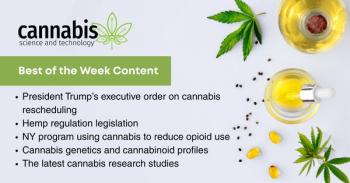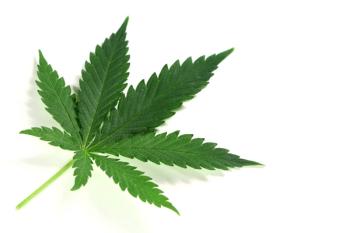
- March/April 2022
- Volume 3
- Issue 1
- Pages: 12-16
Overview of Research on Cannabis for Chronic Pain
In this article, Ruth Fisher explores the prominence of cannabis being used to treat chronic pain patients and data from studies detailing how beneficial it can be.
Types of Pain
In his 1999 address to The American Society of Anesthesiologists, Michael Cousins stated that “chronic pain will be regarded as the disease of the 21st century” (1). Indeed, it is: pain is “a significant public health problem,” afflicting some 11% to 40% of the US population (2). While people talk about pain as if it’s a relatively homogeneous problem, in reality, it’s fantastically diverse, both in what causes it and in how people experience it.
There are many different classification schemes for pain. One way to classify pain is by duration, either acute or chronic. Acute pain generally comes on suddenly, has a specific cause–often tissue damage–and lasts for a limited period, until the wound has healed. In contrast, chronic pain lasts for a much longer period–more than six months in duration–and may be due to any variety of underlying causes (3-5). Notably, chronic pain “is totally different from acute pain because of its pathologic psychobehavioral manifestations” (6), such as social isolation and avoidance.
Cancer pain is often multidimensional and may be either acute (for example, associated with tests or treatments undertaken to address the cancer) or chronic (such as associated with the cancer itself) in nature. Likewise, fibromyalgia and other pain syndromes may be either acute or chronic in nature. And as with cancer, pain syndromes tend to be quite multidimensional and not well-understood (3-5).
Another way to classify pain is by source, either nociceptive or neuropathic. Nociceptive pain is caused by a specific sensory stimulus: extreme heat or cold (burns or frostbite), toxic chemicals, or tissue damage, while neuropathic pain is caused by damage to or disease of the nervous system (3–5).
Based on these two sets of classifications (duration and cause), there are four overlapping categories of pain: acute nociceptive, chronic nociceptive, acute neuropathic, and chronic neuropathic (see Figure 1).
Cannabis and Pain
Cannabis has been used throughout history to treat pain (7), and studies of people who use medical cannabis consistently report pain as being the most common target of cannabis relief (8–10). Scientific research on cannabis for pain was ignited when cannabis was reintroduced into society in the early 1990s with the discovery of the endocannabinoid system (ECS), and the research subsequently caught fire over the past 30 years (see Figure 2).
While cannabis has shown little ability to address acute pain (11), there is a vast pre-clinical body of research examining the mechanisms of action (MoA) of cannabis for addressing different types of chronic pain. Additionally, there is also a substantial collection of clinical trials conducted to test the efficacy of cannabis for different types of chronic pain.
Mechanisms of Action
Direct MoAs of cannabis for reducing chronic pain include reducing chronic inflammation, acting on pathways of chronic pain signaling, and acting on acute and chronic cognitive perceptions of pain. Other indirect MoAs for cannabis to address chronic pain include improving sleep and enhancing the effect of other treatments for addressing pain.
Reduce Inflammation
Cannabis can reduce chronic pain by decreasing inflammation that causes pain.
Typically, our immune system is triggered whenever our body senses trauma or toxins. Both tissue damage (nociceptive) and nerve damage (neuropathic) induce the same type of inflammatory response: nearby blood vessels dilate—causing heat and swelling—and become permeable, enabling various types of immune system cells to flood the site and managethe threat. Some of the substances released in the process “irritate nerves and cause pain signals to be sent to the brain.” By inducing pain, your body is telling you to protect the affected region (12).
Of course, acute inflammation is generally a productive response by your body to very real threats. However, for many people, inflammation transitions from being a productive, acute response to a short-term problem into becoming an ongoing, noxious problem. In these cases of chronic inflammation in which the process is no longer serving a useful response, cannabis can be used to inhibit the inflammatory process. More specifically, the immune system cells responsible for triggering cascades of activity that target perceived threats contain cannabinoid receptors (CBs), which mediate those cascades. As a result, cannabis can be used to act on these immune system cells to disengage the noxious immune response, thereby reducing inflammation, together with any associated pain (13–15).
Mitigate Pain Signaling
Cannabis can reduce chronic pain by inhibiting pain signals at different points along pain signaling pathways to and from the brain.
As illustrated in Figure 3, stimulus in the body that triggers a noxious response (say, in an injured finger) sends information signals along peripheral nerves and through the spine, where it is relayed as ascending input up to the brain. The brain then processes those signals and sends pain signals as descending signals back down to the spinal cord, which, in turn, relays the pain signals through the periphery to the site (16).
Cannabinoid receptors are “strategically located” along the pathways of both the central and peripheral nervous system “where pain signaling is intricately controlled” (14). The ECS mediates pain signals as they ascend and descend pain pathways by acting on cannabinoid receptors located on peripheral nerves, within the spine, and within the brain (13–16). Cannabis can thus be used to mitigate overactive pain activity along the body’s pain signaling pathways.
Modify Pain Perception
Cannabis can reduce chronic pain by changing how we perceive and experience pain in several respects.
First, independently of the strength of the stimulus, negative emotional states, including anxiety and depression, can exacerbate pain experiences. Cannabis’s ability to reduce both anxiety and depression have been well-documented (17). Cannabis thus reduces pain by mitigating negative emotional states that exacerbate sensations of pain.
Second, cannabis can reduce chronic pain experiences by helping to distract us from focusing our attention on pain (18,19).
And third, while cannabis may not decrease the intensity of pain, it has been found to decrease the perceived unpleasantness of pain (20–22).
Other
In addition to its direct mechanisms for addressing pain, cannabis also indirectly aids in reducing pain through indirect mechanisms, including improving sleep, and reducing the need for other pain medications.
Enhance Sleep
Lack of sleep exacerbates perceptions of pain directly as well as indirectly, by exacerbating mood disorders (anxiety and depression) and attention problems, which themselves exacerbate pain. Manyresearchers have thus noted the benefits of using cannabis to “normalize” patients’ sleep, which, in turn, helps decrease pain (24–26).
Decreased Use of Opioids
One of the increasingly celebrated benefits of cannabis is the associated reduction in use of other pain medications, notably opioids. A substantial body of research describes how opiates and cannabinoids complement each other. The two substances “use overlapping signaling systems in the body having to do with drug tolerance, pain, and dependence” (27). As a result, supplementation of opioid use with cannabis can decrease, if not eliminate, the need for opioids (27–30). In fact, studies have shown that Medicare reimbursements for opioids significantly decrease after states legalize medical cannabis (31).
Clinical Trials
There have been many clinical studies performed to assess to efficacy of cannabis for treating pain.
One way to summarize the findings is by study type. A good number of surveys—several of them are surveys of hundreds or thousands of patients—consistently report that most medical cannabis patients use cannabis to treat pain, depression or anxiety, and sleep. Furthermore, survey participants generally report cannabis as being effective for these uses. Additionally, there have been a fair number of placebo-controlled studies of cannabis for pain. Some three and a half dozen randomized controlled trials and an additional three dozen (non-randomized) placebo-controlled trials have been performed to assess cannabis efficacy for pain. Most of these studies include only a few dozen participants, but some do include a few hundred. More than half find statistically significant benefits of cannabis for reducing chronic pain.
Alternatively, we can summarize finding by type of pain. Several studies have been conducted on cannabis for postoperative (that is, acute) pain. As mentioned earlier, these studies tend to find that cannabis is not effective for addressing acute pain. Next, several dozen studies test the efficacy of cannabis for chronic nociceptive and neuropathic pain, and many of these studies find cannabis effective for reducing chronic pain. Third, a dozen studies find cannabis to be an effective substitute for opioids. The last area with a bit more than a handful of studies is that of cannabis for helping pain patients improve sleep, and these studies do find cannabis to be effective for sleep.
This evidence does not constitute the good set of large-scale, randomized, controlled trials that the medical community generally turns to as validating a treatment’s efficacy. Yet, it does provide some assurance that cannabis seems quite promising for addressing chronic pain.
In Sum
Chronic pain is one of the more heavily studied therapeutic applications for cannabis. Preclinical studies have established several clear mechanisms of action of cannabis for addressing chronic pain: reduction of inflammation, mitigation of pain signaling, modification of pain perception, enhancement of sleep, and complement of other traditional therapeutics used to treat pain. A large body of survey data establishes the prevalence and efficacy of cannabis use by patients to treat chronic pain. Finally, a large body of clinical trials also confirms the promise of cannabis for addressing chronic pain.
References
- M. Cousins, “Pain: The Past, Present, and Future of Anesthesiology?” Anesthesiology(1999). Retrieved from
https://pubs.asahq.org/anesthesiology/article/91/2/538/37300/Pain-The-Past-Present-and-Future-of-Anesthesiology . - National Pain Strategy: A Comprehensive Population Health-Level Strategy for Pain. NIH. Retrieved from
https://www.iprcc.nih.gov/national-pain-strategy-overview/national-pain-strategy-report . - J. Saling, “Pain Types and Classifications,” WebMD(2019). Retrieved from
https://www.webmd.com/pain-management/guide/pain-types-and-classifications . - A. Santos-Longhurst, “Types of Pain: How to Recognize and Talk About Them,” Healthline(2018). Retrieved from
https://www.healthline.com/health/types-of-pain . - P. Ingraham, “The 3 Basic Types of Pain,” Pain Science(2019). Retrieved from
https://www.painscience.com/articles/pain-types.php . - W.Raffaeli and E. Arnaudo,“Pain as a disease: an overview,” Journal of Pain Research(2017). Retrieved from
https://www.ncbi.nlm.nih.gov/pmc/articles/PMC5573040/pdf/jpr-10-2003.pdf . - T. Mikuriya,“Marijuana in Medicine: Past, Present, and Future,” California Medicine (1969). Retrieved from
https://www.ncbi.nlm.nih.gov/pmc/articles/PMC1503422/pdf/califmed00019-0036.pdf . - M. Sexton, C. Cuttler, J.S. Finnell, and L.K. Mischley, “A Cross-Sectional Survey of Medical Cannabis Users: Patterns of Use and Perceived Efficacy,” Cannabis Cannabinoid Res. (2016).Retrieved from
https://pubmed.ncbi.nlm.nih.gov/28861489/ . - P. Lucasa and Z. Walsh, “Medical cannabis access, use, and substitution for prescription opioids and other substances: A survey of authorized medical cannabis patients,” International Journal of Drug Policy(2017).. Retrieved from
https://greenleafmc.ca/wp-content/uploads/2019/02/Cannabis-as-a-substitute-for-opioids-and-other-substances-2017.pdf . - The Health Effects of Cannabis and Cannabinoids: The Current State of Evidence and Recommendations for Research, The National Academies Press(2017). Retrieved from
http://nap.edu/24625 - A. Gazendam, et al “Cannabinoids in the Management of Acute Pain: A Systematic Review and Meta-analysis,” Cannabis and Cannabinoid Research(2020). Retrieved from
https://www.liebertpub.com/doi/10.1089/can.2019.0079 . - What is an inflammation? InformedHealth.org(2021).Retrieved from
https://www.ncbi.nlm.nih.gov/books/NBK279298/ . - E. Russo, “Cannabinoids in the management of difficult to treat pain,” Ther. Clin. Risk Manag.(2008). Retrieved from
https://www.ncbi.nlm.nih.gov/pmc/articles/PMC2503660/ . - S. Vuckovic ́, et. al. “Cannabinoids and Pain: New Insights From Old Molecules,” Frontiers in Pharmacology (2018). Retrieved from
https://www.frontiersin.org/articles/10.3389/fphar.2018.01259/full . - J. Guindon and A. Hohmann, “The Endocannabinoid System and Pain,” CNS Neurol Disord Drug Targets(2009). Retrieved from
https://www.ncbi.nlm.nih.gov/pmc/articles/PMC2834283/ . - M. Walker, N. Strangman, and S. Huang, “Cannabinoids and pain,” Pain Res Manage (2001). Retrieved from
https://downloads.hindawi.com/journals/prm/2001/413641.pdf . - E. Russo, “Taming THC: potential cannabis synergy and phytocannabinoid-terpenoid entourage effects,” Br. J. Pharmacol. (2011).Retrieved from
https://www.ncbi.nlm.nih.gov/pmc/articles/PMC3165946/ . - M. Peters, “Emotional and Cognitive Influences on Pain Experience,” Mod. Trends Pharmacopsychiatry(2015). Retrieved from
https://pubmed.ncbi.nlm.nih.gov/26436897/ . - E. Garland, “Pain Processing in the Human Nervous System: A Selective Review of Nociceptive and Biobehavioral Pathways,” Prim Care(2012).. Retrieved from
https://www.ncbi.nlm.nih.gov/pmc/articles/PMC3438523/pdf/nihms-396443.pdf . - J. Pergolizzi Jr., et. al. “The role of cannabinoids in pain control: the good, the bad, and the ugly,” Minerva Anestesiologica (2018). Retrieved from
https://www.minervamedica.it/en/getfreepdf/%252FtyNS2stccksm2TWusJ8U6z%252Bv6uV6LNajNHqXnVc%252B8O1KdeBk12dKITvfl98aZhJ6Y75DlKXV6PoFp9GqFlPuQ%253D%253D/R02Y2018N08A0955.pdf . - M. Lee, et al. “Amygdala activity contributes to the dissociative effect of cannabis on pain perception,” Pain (2013). Retrieved from
https://www.ncbi.nlm.nih.gov/pmc/articles/PMC3549497/pdf/main.pdf . - C. Walter, “Brain Mapping-Based Model of Δ9-Tetrahydrocannabinol Effects on Connectivity in the Pain Matrix,” Neuropsychopharmacology(2016). Retrieved from
https://www.nature.com/articles/npp2015336.pdf . - S. Lake, et. al. “Frequency of cannabis and illicit opioid use among people who use drugs and report chronic pain,” PLoS Med(2019). Retrieved from
https://journals.plos.org/plosmedicine/article/file?id=10.1371/journal.pmed.1002967&type=printable . - P.G. Fine and M.J. Rosenfeld, “The Endocannabinoid System, Cannabinoids, and Pain,” Rambam Maimonides Med J. (2013).Retrieved from
https://www.medicinalgenomics.com/wp-content/uploads/2013/11/Cannabinoids_Pain_PFMR-298.pdf . - V. Modesto-Lowe, R. Bojka, and C. Alvarado, “Cannabis for peripheral neuropathy: The good, the bad, and the unknown,” Cleveland Clinic Journal of Medicine(2018). Retrieved from
https://www.mdedge.com/ccjm/article/189782/drug-therapy/cannabis-peripheral-neuropathy-good-bad-and-unknown . - D. Sulak, “How to Use Cannabis to Reduce and Replace Opioid Medications,” Healer(2018). Retrieved from
https://healer.com/wp-content/uploads/2018/04/Healer-Medical-Cannabis-Opioid-Guide.pdf . - P. Grinspoon, “Access to medical marijuana reduces opioid prescriptions,” Harvard Health Blog(2019, Jun 25). Retrieved from
https://www.health.harvard.edu/blog/access-to-medical-marijuana-reduces-opioid-prescriptions-2018050914509 . - Cannabinoids & Opioids. Accurate Education. Retrieved from
http://accurateclinic.com/accurate-education-medical-marijuana-cannabinoids-opioids/ . - M. Lynch and A. Clark, “Cannabis Reduces Opioid Dose in the Treatment of Chronic Non-Cancer Pain,” Journal of Pain and Symptom Management (2003).Retrieved from
https://www.jpsmjournal.com/article/S0885-3924(03)00142-8/fulltext . - L. Lowe, “Cannabis as a tool in harm reduction: A Canadian perspective,” Health Europa(2019). Retrieved from
https://www.healtheuropa.eu/cannabis-use-as-a-tool-in-the-harm-reduction-of-opioid-use-a-canadian-perspective/92297/ . - A. Bradford, et al. “Association Between US State Medical Cannabis Laws and Opioid Prescribing in the Medicare Part D Population,” JAMA Intern Med. (2018). Retrieved from
https://jamanetwork.com/journals/jamainternalmedicine/fullarticle/2676999 . https://www.frontiersin.org/articles/10.3389/fphar.2018.00916/full .https://www.ncbi.nlm.nih.gov/pubmed/28328576 .https://www.sciencedirect.com/science/article/pii/S0304395902004001 .
About the Author
Ruth Fisher, PhD, is a systems design researcher and analyst. She analyzes markets to determine how environments shape outcomes. She is co-founder of CannDynamics, Inc., and author of The Medical Cannabis Primer and Winning the Hardware-Software Game: Using Game Theory to Optimize the Pace of New Technology Adoption. Dr. Fisher has worked in the technology and healthcare sectors on behalf of technology companies, early-stage researchers, physicians, and technology start-ups.
Articles in this issue
over 3 years ago
March/April 2022 Digital Editionover 3 years ago
Chronic Pain: Data Snapshotover 3 years ago
Finding Relief with Cannabisover 3 years ago
Eyewitness: Cannabis Should Be the Chronic Pain Treatment Choiceover 3 years ago
Chronic Pain Advocacy: It’s Time to Testify!Newsletter
Unlock the latest breakthroughs in cannabis science—subscribe now to get expert insights, research, and industry updates delivered to your inbox.




